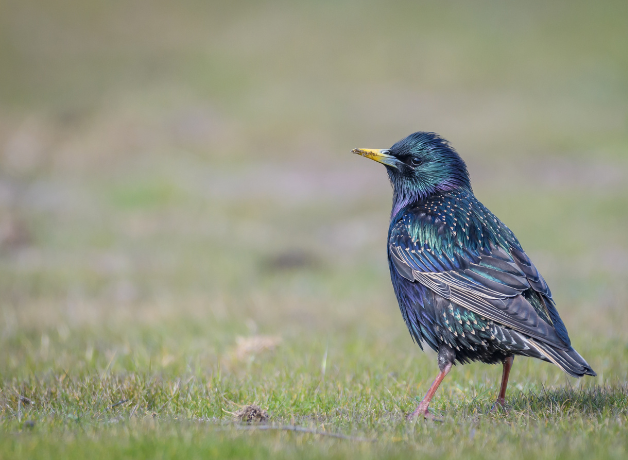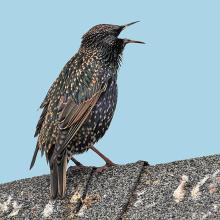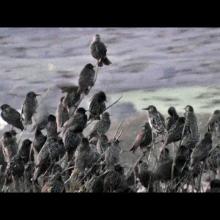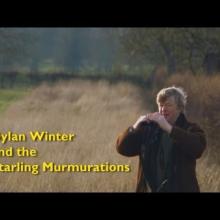

Join BirdNote tomorrow, November 30th!
Illustrator David Sibley and actor H. Jon Benjamin will face off in the bird illustration battle of the century during BirdNote's Year-end Celebration and Auction!
Invasive European Starlings are one of the most common birds in North American cities. Recent genetic research into European Starlings shows that populations in North America may have become better adapted to thrive in arid environments and colder temperatures compared to the milder climate of their home range in Europe. Evolution is an ongoing process, and sometimes the best examples can be found in birds that live right alongside us in cities.
BirdNote®
Starlings Evolving in New Habitats
Written by Conor Gearin
This is BirdNote.
[Flock of European Starlings, ML282613271]
European Starlings, first introduced in New York City, have become invasive and compete with native species for nesting sites. They’re now one of the most common birds in many cities across North America. But as they’ve entered new habitats, they’ve begun to change.
[European Starling call, ML107248]
The starlings’ ancestors lived in mild and temperate climates in Europe. In the U.S., they’ve encountered environments quite unlike where they came from: long, frigid winters as well as dry deserts and plains.
Recent genetic research into European Starlings shows that their DNA is changing, possibly because starlings in North America have more genetic adaptation to thrive in arid environments and colder temperatures compared to those still in Europe.
European Starlings have also been introduced in Australia. There, the starlings’ invasion is more limited in scope. But they also show a pattern of genetic change. Genes that help the starlings regulate their cells under more extreme conditions may be favored for birds spreading out further from where they were introduced.
[European Starling call, ML107248]
Evolution is an ongoing process, and sometimes the best examples can be found in birds that live right alongside us in cities.
For BirdNote, I’m Ariana Remmel.
###
Senior Producer: Mark Bramhill
Producer: Sam Johnson
Managing Editor: Jazzi Johnson
Content Director: Jonese Franklin
Bird sounds provided by The Macaulay Library of Natural Sounds at the Cornell Lab of Ornithology, Ithaca, New York. European Starling ML107248 recorded by Wil Hershberger. European Starling ML282613271 recorded by Bernard Tremblay.
BirdNote’s theme was composed and played by Nancy Rumbel and John Kessler.
© 2025 BirdNote February 2025
Narrator: Ariana Remmel
ID# EUST-08-2025-02-12 EUST-08
References:
Genes associated with arid environments and colder temps that are different than the mild climates of Europe are increasing in frequency in North American starlings
https://digitalcommons.unl.edu/cgi/viewcontent.cgi?article=3405&context=icwdm_usdanwrc
In Australia, starlings on the edge of the invasion front have differences in their genetics from birds at the place where the invasion began.
https://onlinelibrary.wiley.com/doi/abs/10.1111/mec.15601
Preprint: https://www.biorxiv.org/content/10.1101/643569v3.full.pdf
Australia and U.S. compared and contrasted here:
https://onlinelibrary.wiley.com/doi/pdf/10.1111/mec.15794
House Sparrows evolved quickly, too
https://www.jstor.org/stable/pdf/2406496.pdf






